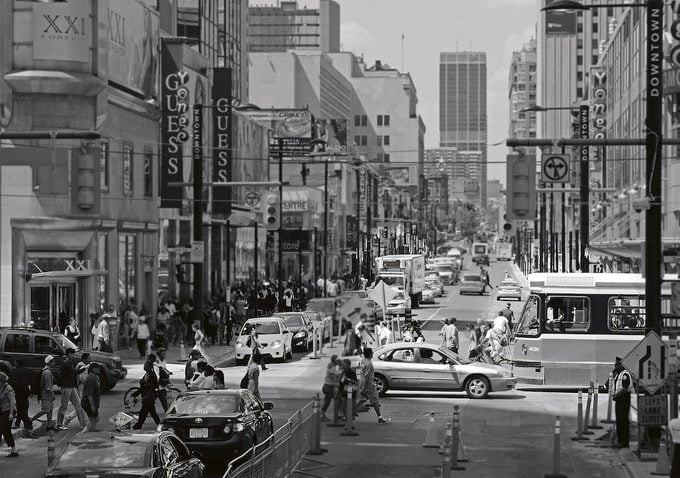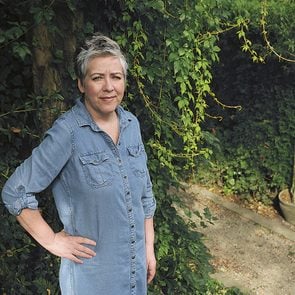Why City Noise Is Bad for Your Health

Background noise—from traffic, from industry—is killing us. Here’s what you can do about it.
For much of last summer, I was serenaded by a chorus of circular saws, lawn mowers and wood chippers outside my Toronto apartment. Some days, a mysterious banging from a nearby neighbour joined in. If you’ve spent the pandemic mostly working from home, you’ve probably become well acquainted with the sounds around your home, too. Not all of them have been pleasant! But if you listened closely and ventured out into the streets, you might have also heard something else—or rather, a surprising lack of something else, for city dwellers and suburbanites alike. The birds seemed louder. Voices carried further. In some places, construction had even paused.
The sudden shift was palpable. With fewer cars on the road, noise measurements in cities across Canada, the U.S. and Europe dropped significantly. Seismologists could actually see our behaviour shift, the usual vibrations of human activity now dulled. Microphones in cities around the world captured what The New York Times called “human-made environments suddenly stripped of human sounds.” Our cities, once loud, had been silenced. It was tempting to wonder: what if life were this quiet all the time?
Noise is too often thought of as a personal problem and not a societal concern. But Tor Oiamo, an assistant professor of geography and environmental studies at Ryerson University, hopes his research will make you think differently. For over a decade, Oiamo has been studying the long-term health effects of background or environmental noise—the minimum level of noise observed in an environment, the kind of noise so pervasive, so part of the fabric of daily life, that it could never justify a complaint to the city.
“What comes to people’s minds most of the time when they think about noise,” says Oiamo, “are things like your neighbour doing construction, or the dog, or concert events—these things that basically stand out from background noise levels.”
As annoying as these daily intrusions may be, they don’t pose as much of an impact on our health as the chronic, long-term nuisances we’ve learned to cope with or ignore. That is, the constant thrum of highway traffic, manufacturing and warehouse activity—the stationary sounds that ripple outward day after day, year after year. This is the kind of noise you might have never noticed until quarantine turned the volume down in 2020.
Aside from the obvious impacts excessive environmental noise has on sleep, mood and quality of life, it’s also detrimental to cognitive, cardiovascular and mental health, according to the World Health Organization. The people who suffer the most tend to be among our cities’ most marginalized and disadvantaged, while quiet is for those with privilege and money. While what we hear in the foreground certainly matters, there’s mounting evidence that the background noises so many Canadians have learned to cope with or tune out deserve our attention, too. All it took was a global pandemic for us to hear the difference.

A Noisy History
The soundscape of our cities in the early 20th century was a cacophonous din: trucks rumbling, newsboys shouting, streetcars screeching, milk bottles clattering, children screaming, radios blaring, factories whistling, dogs barking and, most hated of all, car horns honking at all day and night.
By the mid-1920s, the anti-noise movement was in full swing. Organized campaigns decried “needless noise” and urged order be brought to the city. Noise was deemed unneighbourly. G.R. Anderson, an acoustics professor at the University of Toronto known all over Canada as “the Noise Professor,” was a fixture in the press. He used a cutting-edge portable sound-measuring device called an audiometer to rank the city’s worst offenders (number one: streetcars).
Adelaide Plumptre, only the third woman to serve on Toronto city council, proposed a bylaw against “unnecessary noise,” and on June 26, 1939, it came into effect. Shouting, honking and bell ringing were outlawed. Old cars had to run quietly. Radios had to be turned down low. People could be fined up to $50 for each offence—the equivalent of more than $900 today.
Toronto’s anti-noise efforts took cues from New York City, where the mayor, Fiorello La Guardia, waged his own “war on noise.” In 1936, the city passed one of the first comprehensive noise bylaws in North America. La Guardia, wrote cultural historian Lilian Radovac, “approached noise as an aural barometer of the chaos of New York City,” both as a symptom and a cause of urban disorder. Noise went from something city builders tried to mitigate to a moral failing to be policed, licensed and controlled.
In reality, noise complaints in New York were used as a pretext to hassle the original Black and immigrant residents of gentrifying neighbourhoods, to disrupt political protests and strikes, to get merchants off the sidewalks and children out of the streets and to maintain the status quo. In Toronto, the city’s police chief, D.C. Draper, sought authority to deny vehicles with loudspeakers permission to participate in parades. And noise bylaws are still wielded against marginalized groups today.
Radovac points to the cancellation of Carnival Kingdom, a Caribbean culture and music festival held in Vaughan, Ont. in 2018, after the city received complaints of excessive noise. “Why? Is it because they’re Black? Is it because these sounds aren’t perceived to have a wider community value, like the Air Show?” says Radovac. “When you look at what gets shut down and what doesn’t, who gets targeted and who doesn’t, patterns start to emerge.”
While noise complaints have long been used as a cover for racism, classism and political opposition, there is something that some early anti-noise campaigners got right: certain types of environmental noise can be incredibly harmful to human health.
Noise and Our Health
With the 1960s came the promise of supersonic flight. Oklahoma City had aspirations of becoming America’s first supersonic hub. But no one quite knew how its residents would deal with the sonic booms. “Would everyone eventually adapt, or would the country be slowly driven insane?” wrote Sam Anderson in his 2018 book, Boom Town. The answer was Operation Bongo, a six-month U.S. government campaign to subject the residents of Oklahoma City to multiple sonic booms each day, varying in intensity. As you might expect, residents were anxious, frustrated and very annoyed.
Much as cars had remade the soundscape of the streets, air travel remade the soundscape of the sky. Soon, noise was seen as an environmental scourge on par with pollution and became a full-blown public health issue in the 1990s. A growing number of studies suggested links between excessive noise exposure and chronic adverse health effects, from heightened blood pressure to cognitive impacts on memory, performance and concentration.
There are many to choose from, but one 2011 study of the Danish population found that people aged 65 and over faced a 27 per cent higher risk of stroke when noise exposure went up by 10 decibels (dB). A separate study by some of the same researchers linked a 10 dB increase in traffic noise with a 12 per cent higher risk of heart attack.
Ryerson’s Oiamo and his colleagues published the first comprehensive study of environmental noise in Toronto with the city’s public health department in 2017. “The number of people exposed to harmful levels is most definitely increasing,” Oiamo says. Unsurprisingly, the study found that road traffic contributed 60 per cent of background noise, and people living near major roads, highways and mixed commercial areas were especially vulnerable to excessive levels.
Over 60 per cent of Toronto residents experienced traffic noise levels above 55 dBA during daytime hours. (While dB measures sound intensity, the term “dBA” refers to both sound intensity and how the human ear responds to it.) And while that level dropped to 50 per cent of residents at night, this level of noise still exceeds World Health Organization guidelines of 53 dBA for road traffic during the day and 45 dBA at night. Over a 24-hour period during weekdays, the overall average noise levels for Toronto were about 63 dBA—about as loud as a normal conversation, but one that never ends. (Montreal and Vancouver both have similar noise levels.)
Lower-income areas were almost 11 times more likely to have half their residents exposed to excessive nighttime noise than higher-income areas. Put another way, a quiet life is a privileged life, available to people who can afford a well-insulated unit, a detached suburban home on a residential street or an apartment on the upper floors of a building, nowhere near the street at all.
Given all this, you would think we would be more concerned. “We’re seeing long-term effects on hypertension, diabetes and cardiovascular disease,” Oiamo says—effects that can be even worse for people in lower-income or marginalized communities, who often have more limited access to health care, are more likely to be stressed and in general have lower life expectancy. Why, then, don’t we treat environmental noise the way we do other sonic intrusions in our lives?
What Cities Are Doing to Help
Before the pandemic, Toronto’s two most frequent noise complaints were related to construction and amplified sound. It’s not hard to see why. They’re the types of intrusions you can’t help but notice, the exceptions to the norm. “When you’re in your apartment and your neighbour is blasting music, you can pinpoint who it is, where it’s coming from and why you hate it,” said Radovac.
The city has 24 dedicated bylaw officers who respond to noise complaints from 6 a.m. to 2 a.m. the next day. Officers use sensitive, objective measuring devices to ensure compliance with newly set decibel limits. But background noise is more pernicious. It’s always there—and there’s nothing you can do about it, not by yourself. You can’t complain to 311. In fact, the city’s bylaw officers take into account background noise from distant highways and industrial work in their readings when investigating a noise complaint.
As a society, there are different levers we need to pull. In October 2019, Toronto released a noise action plan “aimed at reducing exposure to ambient environmental noise over time” (Vancouver and Ottawa have also released guidelines in recent years). It recommended that public-transit agencies prioritize noise mitigation in their planning and adopt more electric vehicles. Speed limits could be reduced, freight trucks rerouted and roads kept in better repair. Beyond Toronto, the national building code now requires more comprehensive soundproofing—something Radovac says would go a long way toward separating people from harmful noise levels. To measure and understand how noise levels change over time, Montreal has even proposed the creation of a city-wide noise observatory, essentially a permanent version of Oiamo’s Toronto study.
The goal shouldn’t be to make our cities quieter but to reduce the number of people, and types of communities, exposed to harmful levels of sound. Doing so won’t be easy; it will require us to confront multiple interconnected inequities at once. In Toronto and Montreal, research has shown that Black residents and residents of colour are those most impacted by noise. They’re also the ones who the pandemic has affected most. You can’t treat one and not the other when the underlying causes are the same.
As pandemic restrictions loosen, people are slipping back into their old routines. Factories and warehouses are humming again. Cars have returned to the road. The background noise is, well, back. The saws, the mowers, the mysterious hammering are still as annoying as ever, but remember, they’re merely temporary neighbourhood nuisances. The real threats are harder to hear because they’re always there—a part of the soundscape itself.
© 2020, Matthew Braga. From “How Noise Shaped a City,” from The Local (August 25, 2020), thelocal.to






